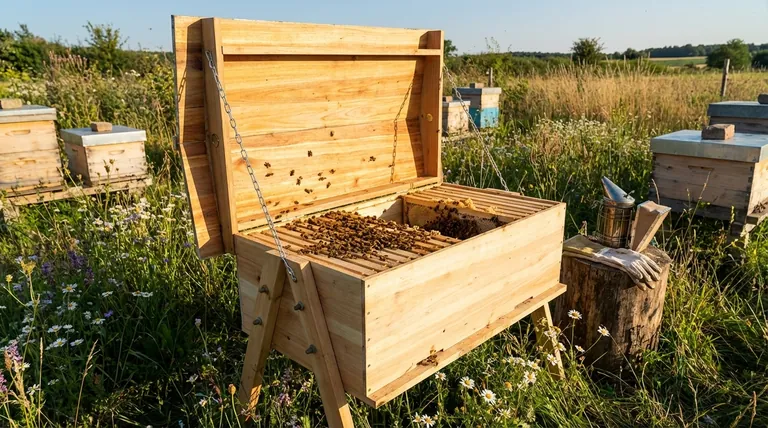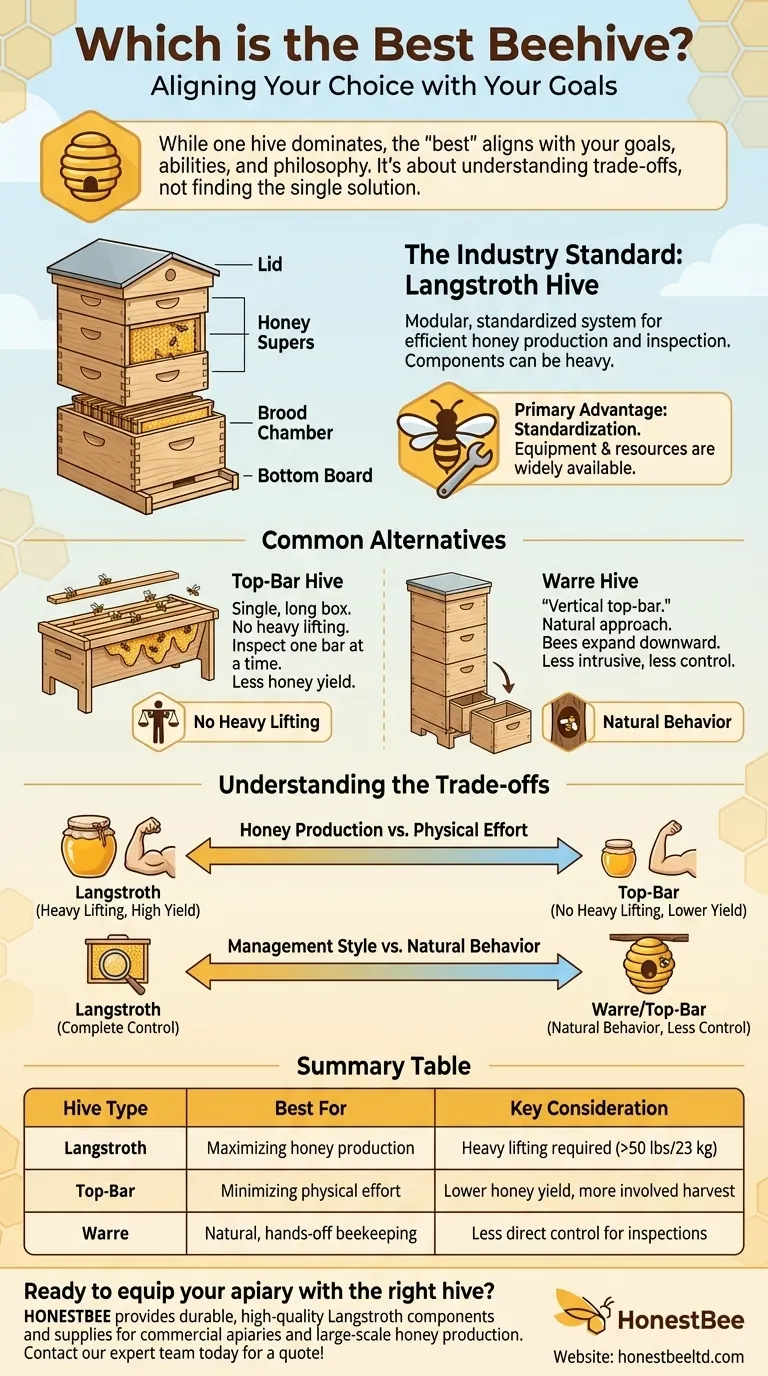While one hive dominates the industry, the "best" beehive is the one that best aligns with your personal goals, physical abilities, and beekeeping philosophy. The most common answer is the Langstroth hive, which is a modular system of stackable boxes with removable frames, making it highly efficient for honey production and hive inspections. However, its components, especially the honey-filled boxes (supers), can be extremely heavy.
The central challenge is not finding the single "best" hive, but rather understanding the trade-offs between different designs. Your choice will balance factors like honey yield, ease of management, physical strain, and your overall approach to beekeeping.

The Industry Standard: The Langstroth Hive
The Langstroth hive is the most recognizable and widely used hive in North America for good reason. Its design, dating back to the 1850s, revolutionized beekeeping.
A System of Components
A Langstroth hive is a set of modular parts. It includes a brood chamber (or hive box) for the queen to lay eggs, honey supers where bees store surplus honey, a lid, and a bottom board.
This component-based system allows for systematic inspection and management, as each frame can be removed individually.
Primary Advantage: Standardization
The overwhelming benefit of the Langstroth is its standardization. Equipment, parts, and educational resources are widely available.
This makes it easier to find a mentor, take a class, or buy new equipment from any supplier. For beekeepers focused on maximizing honey production, this is the proven, go-to system.
Common Alternatives for Different Goals
While the Langstroth is the standard, other designs cater to different priorities, particularly for backyard or hobbyist beekeepers.
The Top-Bar Hive
The Top-Bar hive is a single, long box with simple bars laid across the top. Bees build their comb down from these bars naturally, without frames or foundation.
Its primary advantage is the lack of heavy lifting. There are no heavy honey supers to lift; you inspect and harvest one bar (and its attached comb) at a time.
The Warre Hive
Often called the "vertical top-bar," the Warre hive is designed for a more hands-off, natural approach to beekeeping. It consists of multiple, smaller, square boxes.
Instead of adding boxes for honey to the top, the beekeeper adds new empty boxes to the bottom, allowing the colony to expand downward as it would in a hollow tree.
Understanding the Trade-offs
Choosing a hive means accepting a set of compromises. What you gain in one area, you often sacrifice in another.
Honey Production vs. Physical Effort
The Langstroth is designed for efficient honey extraction but requires lifting boxes that can weigh over 50 pounds (23 kg).
The Top-Bar hive eliminates heavy lifting entirely, but harvesting honey is more involved and typically yields less than a Langstroth.
Management Style vs. Natural Behavior
The Langstroth's removable frames offer complete control and easy inspection, which is ideal for proactive management and health checks.
The Warre and Top-Bar hives are less intrusive, promoting more natural bee behavior at the cost of less direct control for the beekeeper.
Making the Right Choice for Your Goal
Ultimately, the best hive is an extension of your beekeeping objectives.
- If your primary focus is maximizing honey production and using standard equipment: The Langstroth hive is the clear and most supported choice.
- If your primary focus is minimizing heavy lifting and practicing less-intrusive beekeeping: The Top-Bar hive is an excellent and highly accessible option.
- If your primary focus is observing bees in their most natural state with minimal intervention: The Warre hive best aligns with this hands-off philosophy.
Choosing the right hive is the first step in a rewarding partnership with your bees.
Summary Table:
| Hive Type | Best For | Key Advantage | Key Consideration |
|---|---|---|---|
| Langstroth | Maximizing honey production | Standardized, efficient equipment | Heavy lifting required (>50 lbs/23 kg) |
| Top-Bar | Minimizing physical effort | No heavy supers to lift | Lower honey yield, more involved harvest |
| Warre | Natural, hands-off beekeeping | Mimics natural colony expansion | Less direct control for inspections |
Ready to equip your apiary with the right hive?
As a trusted wholesale supplier to commercial apiaries and equipment distributors, HONESTBEE provides the durable, high-quality Langstroth components and other beekeeping supplies you need to succeed. Our bulk-focused operations ensure you get the reliable equipment required for efficient, large-scale honey production and hive management.
Contact our expert team today to discuss your specific needs and get a quote for your operation.
Visual Guide

Related Products
- Long Langstroth Style Horizontal Top Bar Hive for Wholesale
- HONESTBEE Professional Multi-Functional Hive Tool with Ergonomic Wood Handle
- Langstroth Bee Hives Bee Keeping Box for Beginners Beekeeping
- HONESTBEE Advanced Ergonomic Stainless Steel Hive Tool for Beekeeping
- HONESTBEE Professional Long Handled Hive Tool with Precision Cutting Blade
People Also Ask
- What are the box management requirements for a top bar hive vs. Langstroth? Choose Your Hive Strategy
- What is a top bar bee hive? A Natural, Low-Stress Beekeeping Solution
- How are entrances designed in top bar hives? Master Beehive Layout for Maximum Honey
- What are the main differences between Langstroth hives and top bar hives? Choose the Right Hive for Your Beekeeping Goals
- What are the benefits of the top bar hive? A Guide to Ergonomic, Natural Beekeeping



















